Gonystylus, is a southeast Asian genus of about 30 species of hardwood trees also known as ramin, melawis (Malay) and ramin telur (Sarawak).

Pimelea, commonly known as rice flowers, is a genus of plants belonging to the family Thymelaeaceae. There are about 150 species, including 110 in Australia and thirty six in New Zealand.
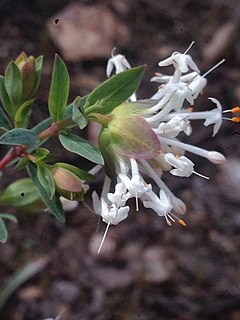
Pimelea linifolia, commonly known as slender rice flower is a common, variable shrub widespread throughout eastern Australia. It has narrow leaves arranged in opposite pairs, and usually white flowers arranged in heads of seven or more on the ends of the stems, with four lance-shaped bracts at the base of the inflorescence. The plant may be toxic to livestock.
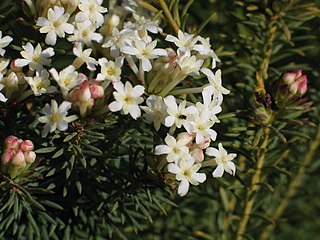
Gnidia is a genus of flowering plants in the family Thymelaeaceae. It is distributed in Africa, Madagascar, Arabia, India, and Sri Lanka; more than half of all the species are endemic to South Africa. Gnidia was named for Knidos, an Ancient Greek city located in modern-day Turkey.
Pimelea microcephala is a dioecious shrub in the family Thymelaeaceae, native to Australia. It grows up to 4 metres high and produces greenish-yellow flowerheads. The male flowerheads have 13 to 100 flowers while the female flowerheads have 7 to 12. The leaves are 7 to 40 mm long and 1 to 4 mm wide.

Pimelea humilis, also known as common riceflower or dwarf riceflower, is a shrub in the family Thymelaeaceae, native to Australia. It grows up to 0.5 metres in height. Flowerheads have 12 to 52 whitish flowers that are either female or bisexual. The leaves are 5 to 15 mm long and 2 to 8 mm wide.

Pimelea flava is a shrub in the family Thymelaeaceae which is endemic to Australia.
Henry Hammersley Travers was a New Zealand naturalist, professional collector and taxidermist. He was the son of the politician William Travers.

Pimelea octophylla, commonly known as woolly riceflower or downy riceflower, is a shrub in the family Thymelaeaceae. The speciesis native to south-eastern Australia. It grows up to 1 metre high and produces cream to pale yellow terminal flowerheads with long white hairs. The flowerheads have 25 to 150 flowers. The leaves are 2 to 15 mm long and 0.5 to 5 mm wide.
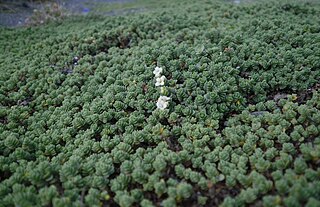
Pimelea urvilleana subsp. urvilleana, commonly known as pinatoro, is a ground spreading shrub native to New Zealand.

Pimelea longifolia, also known as long-leaved pimelea and tāranga, is a small shrub native to New Zealand.
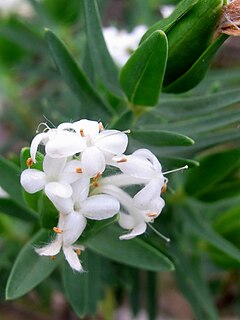
Pimelea congesta is a flowering plant in the Thymelaeaceae family. The specific epithet refers to the congested inflorescence.
Pimelea villosa, also known as Pimelea arenaria, is a species of shrub in the family Thymelaeaceae. It is endemic to New Zealand. Its conservation status puts it at risk and declining, as determined by the New Zealand Threat Classification System (NZTCS).
Pimelea virgata is a species of small shrub, of the family Thymelaeaceae. It is native to Australia.
Pimelea prostrata, also known as Strathmore weed, is a species of small shrub, of the family Thymelaeaceae. It is endemic to New Zealand.
Pimelea lyallii, commonly known as the Southern sand daphne, is a species of small shrub, of the family Thymelaeaceae.
Pimelea traversii is a species of shrub in the family Thymelaeaceae. It is native to New Zealand. The specific epithet traversii is in honor of naturalist Henry H. Travers (1844-1928), son of William Thomas Locke Travers.

Pimelea actea is a small coastal plant native to New Zealand. It was named and described by Colin J. Burrows in 2008 as part of a revision of the New Zealand Pimelea, a project he had begun as a Master's thesis in the 1950s and continued in his retirement. Burrows described the species, which for some time had been referred to as Pimelea "Turakina", from a specimen collected in 1968, now in the Auckland Museum. Its species name, actea, means "coastal".
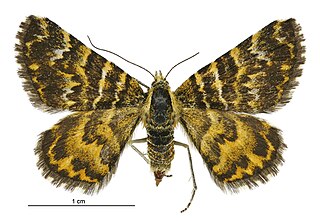
Notoreas elegans is a species of moth in the family Geometridae. It is endemic to New Zealand. This species has a wide distribution in New Zealand and is therefore regarded as not being in need of conservation.












